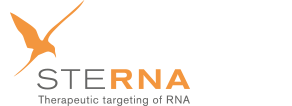Marburg, Germany, 09 May 2012
-
Superior results achieved compared to other drug carrier systems such as W/O emulsions, microemulsions, and submicron emulsions
A paper published in the International Journal of Pharmaceutics (Schmidts et al., 2012) found that the formulation employed in sterna biologicals’ drug candidate SB011 is an excellent dermal delivery system for DNAzymes.
The researchers demonstrated that packaging DNAzymes in the inner water phase of a water-in-oil-in-water (W/O/W) emulsion resulted in superior effects compared to W/O emulsions, microemulsions (MEs), and submicron emulsions (SMEs). W/O emulsions are known to effectively encapsulate sensitive substances, whereas MEs and SMEs have improved skin penetration characteristics.
The W/O/W emulsion combined the excellent protective properties of W/O emulsions against DNases with a nearly four-fold higher skin uptake of the DNAzyme compared to SMEs when applying a finite dose under low pressure massage. FACS analysis of FAM-labelled DNAzyme furthermore revealed superior cellular uptake of the DNAzyme in the W/O/W formulation as compared to the SME formulation.
Sterna biologicals intends to commence clinical trials of SB011 for the treatment of atopic dermatitis in H2 2012.
References
Schmidts T, Marquardt K, Schlupp K, Dobler D, Heinz F, Mäder U, Garn H, Renz H, Zeitvogel J, Werfel T, Runkel F. Development of Drug Delivery Systems for the Dermal Application of Therapeutic DNAzymes. Int J Pharmaceut 2012. [Epub ahead of print]
About SB011
sterna biologicals’ drug candidate SB011 is a topically applied DNAzyme-based GATA-3 antagonist for the treatment of atopic dermatitis. The DNAzyme is packaged in a novel proprietary emulsion which supports skin penetration and effectively protects the molecule from degradation. GATA-3 is the master transcription factor in regulating Th2-driven inflammatory diseases such as atopic dermatitis. It is generally accepted that GATA-3 is necessary and sufficient for the production of key cytokines interleukin (IL)-4, IL- 5, and IL- 13, which cause inflammation. In pre-clinical development, SB011 significantly reduced expression of these cytokines and was safe and well-tolerated in toxicological studies with negligible side-effects. DNAzymes are single-stranded DNA molecules comprising a catalytic domain flanked by two binding domains. The binding domains attach to a specific sequence of targeted mRNA (antisense), in case of SB011 GATA-3 mRNA. After binding to the target, the catalytic domain then cleaves the mRNA, thereby inhibiting relevant cytokine expression.
About atopic dermatitis
Atopic dermatitis is a chronic inflammatory disease of the skin. The skin reacts to normally harmless irritants such as allergens and develops an immune response, often compounded by bacterial surface infections as the skin becomes dry or damaged. In developed countries, approximately 1 to 3% of adults and 5 to 20% of children are affected by atopic dermatitis.
